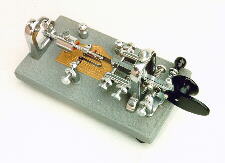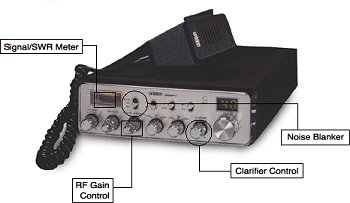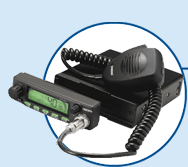
2-way Radio Info
by Alan

This page combines some useful information about common 2-way radios, including CB, UHF and HF-Marine radios, detailing their frequencies, channels, and uses of those channels. It also contains the Phonetic Alphabet, Morse code, and some useful statistics relating to antenna tuning.
Modes of transmission:
| Mode | Meaning | General Usage & Comments |
| AM | Amplitude Modulation | Frequencies less than 30MHz. Lower quality audio. Includes normal radio stations (500KHz-1.6MHz), CB radio (27MHz) and most short wave stations (2MHz-30MHz) etc. |
| FM | Frequency Modulation | Frequencies above 30MHz. Higher quality audio. Includes normal FM radio stations (88MHz-108MHz), VHF police & aircraft (50MHz), VHF Amateur radio (144MHz), UHF CB (470MHz), UHF Amateur radio etc |
| SSB | Single side band (includes LSB & USB) | Frequencies in the 2MHz-30MHz. Poor quality audio. Esed commonly for long-distance communications, including Short-wave and 27MHz CB. |
| LSB | Lower side band | As above. |
| USB | Upper side band | As above. |
| CW | Continuous Wave (Morse code, On/Off) | This does not support audio. Rather is is just a continuous tone, as in Morse code trasmissions. |
OFFICIAL PHONETIC ALPHABET and Morse code:
The phonetic alphabet is commonly used to spell out letters, when communications are dificult to understand, as in long distance coms, or noisy environments. The Morse code is not used commercially any more, and was officially phased out in 1999, although it is sometimes still used by Amateur radio enthusiasts. And we all know that the SOS signal ( ... --- ... ) is still often reffered to.
| A .- Alpha B -... Bravo C -.-. Charlie D -.. Delta E . Echo F ..-. Foxtrot G --. Golf H .... Hotel I .. India J .--- Juliett K -.- Kilo L .-.. Lima M -- Mike 0 ----- |
N -. November O --- Oscar P .--. Papa Q --.- Quebec R .-. Romeo S ... Sierra T - Tango U ..- Uniform V ...- Victor W .-- Whiskey X -..- X-ray Y -.-- Yankee Z --.. Zulu 5 ..... |
 |
Guide to tuning 2-Way Radio Antenna:
Antenna's on 2-way radio's need to be tuned to the frequency that they will be operating on. Although most antenna's sold by retail stores are pre-tuned, this tuning is often out, and can be improved upon. The tuning can also vary depending upon the way the antenna is mounted, and what type of antenna base / spring you have. If the tuning is way out, you can risk damaging the transmitter circuit in the radio. Some common reasons for the tuning to be way out are; A) if you are using the wrong antenna, B) if the antenna has a bit broken off it, C) if the wire that wraps around the antenna is cut, D) if there is a loose wire or short circuit in the coax leading to the antenna. So it is a good idea to borrow an SWR Meter to check the ratio. SWR stands for Standing Wave Ratio, and is basically a measure of the efficiency of the antenna circuit. The following chart is a guide to interpreting the readings...
|
PERCENT POWER INTO ANTENNA |
COMMENTS |
1:1 |
100% | Perfect |
1.05:1 |
99.93% | Excellent |
1.1:1 |
99.78% | Excellent |
1.2:1 |
99% | Very Good |
1.5:1 |
96% | Good |
2:1 |
88% | Improve if possible |
2.5:1 |
82% | Improve if possible |
3:1 |
75% | Bad - risk damage to transmitter |
HF 27MHz Citizen Band (AM CB) Frequency / Channel chart:
|
Freq. Old Channel Usage 26.965 - 1 AM 27.620 COMMON WALKIE TALKIE CHANNEL |
 |
HF Marine Band (27MHz):
| MHz | Ch# | Usage |
| 27.680 | Commercial organizations, Ship-shore / inter-ship | |
| 27.720 | Professional fishermen, Ship-shore / inter-ship | |
| 27.820 | Professional fishermen, Inter-ship | |
| 27.860 | 1 | Secondary distress, Safety / weather info, Amateur organizations |
| 27.880 | 2 | Emergency channel, Priority distress |
| 27.900 | 4 | General, Ship-shore, Amateur organizations (Calling and working) |
| 27.910 | 5 | General, Ship-shore, Amateur organizations (Calling and working) |
| 27.940 | 6 | Club events, Ship-shore / inter-ship (Calling and working) |
| 27.960 | Amateur organizations, Inter-ship | |
| 27.980 | Surf rescue |
UHF 476MHz Citizen Band (UHF CB)
| Freq. Channel Usage 476.425 1 FM Repeater output |
Freq. Channel Usage 476.925 21 FM |
 |
Ten Codes for CB Radio
The "10" codes were used in the early days of CB radio, and had 2 primary functions. First, they offered an abbreviation to common messages, and secondly, they helped communications when the signals were week, because simple numbers were more easily understood. Although the "10" codes are not often necessary now-a-days with modern FM transceivers, it is still common for people to say "10 - 4" at the end of their sentences, which simply means, "yes" or "over". Here is a list of common Ten Codes...
| "10" Code | Meaning |
|
10
- 1 |
Receiving poorly |
|
10
- 2 |
Receiving well |
|
10
- 3 |
Stop
transmitting (Standby |
|
10
- 4 |
Message
Received (Yes,
ok, roger) |
|
10
- 5 |
Relay message too ... |
|
10
– 6 |
Busy
at present |
|
10
- 7 |
Out
of service, off the air |
|
10
- 8 |
In
service, on the air |
|
10
- 9 |
Repeat |
|
10
- 10 |
Transmission
completed, Standby |
|
10
- 13 |
Advise
Weather
and road conditions |
|
10
- 20 |
My
Location |
|
10
- 27 |
I
am Moving
to channel |
|
10
- 30 |
Illegal
use of radio |
|
10
- 33 |
Emergency
traffic on the channel |
|
10
- 34 |
Request
for assistance |
|
10
- 36 |
Correct
time |
|
10
- 46 |
Assist
motorist |
|
10
- 77 |
Negative
contact |
| 10 - 99 | Mission completed, all units secure |
|
10
- 100 |
Rest
stop |
| 10 - 200 |
Official meaning: Police needed at ...
Common meaning: T |
http://home.att.net/~wizardoz/cbmw/10codes.html
http://www.roity.com/rc/cbradio/cbcodes.html
Send me some feedback about these pages, by emailing me.
This page was last updated on 15 Apr 2004